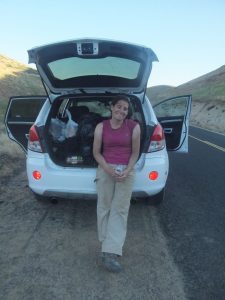 Research Statement
Research Statement
The last 2 million years of Earth’s history has been characterised by abrupt climatic shifts between warm interglacial and cold glacial conditions which profoundly impacted the Earth’s surface. I am principally interested in understanding how and when environmental change occurred, which I achieve through the development and application of novel trapped-charge dating methods i.e. Luminescence and Electron Spin Resonance dating. I am currently working on projects in the Himalaya, the Atacama desert, the Japanese and European Alps.
Biography
I obtained a BA (Hons) in Geography from the University of Oxford in 2004 followed by an MSc in Quaternary Science at Royal Holloway/University College London which I completed in 2007. I then moved to the University of St Andrews in Scotland to pursue a PhD in Earth Sciences supervised by Ruth Robinson and Adrian Finch which I completed in 2011. My PhD research concerned understanding the fundamental and sedimentological controls on the luminescence of quartz and feldspar minerals with a field site of Jostedalen in Norway. In 2012 I was appointed as a post-doctoral Research Fellow in the Aberystwyth Luminescence Research Laboratory, Wales, collaborating with Helen Roberts, Geoff Duller and Nicholas Pearce. In 2013 I was appointed as a Senior Scientist in the Institute of Earth Surface Dynamics where I helped Frédéric Herman to establish the luminescence dating facility and primarily worked on the establishment of luminescence thermochronometry. In 2015 I moved to the University of Cologne, Germany to head the Cologne Luminescence Laboratory and was offered tenure in 2016. In 2016 I secured an Ambizione fellowship and returned to Switzerland to the University of Bern, before returning to the Institute of Earth Surface Dynamics to establish a research group in mid-2018.
Selected publications (full list of publications)
King, G.E., Tsukamoto, S., Herman, F., Biswas, R., Sueoka, S., Tagami, T., 2019. ESR-thermochronometry of the Hida range of the Japanese Alps: Validation and future potential. Geochronology, 2, 1-15. doi.org/10.5194/gchron-2-1-2020
Lehmann, B., Herman, F., Valla, P.G., King, G.E., Biswas, R.H., Ivy-Ochs, S., Steinemann, O. and Christl, M., 2020. Postglacial erosion of bedrock surfaces and deglaciation timing: New insights from the Mont Blanc massif (western Alps). Geology, 48(2), pp.139-144.
Riedesel, S., King, G.E., Prasad, A. K., Kumar, R., Finch, A. A., Jain, M., 2019. Optical determination of band-tail width, depth and excited state of the IRSL trap in feldspar. Radiation Measurements 125, 40-51.
King, G.E., Burow, C., Roberts, H.M., Pearce, N.J.P., 2018. Age determination using feldspar: evaluating fading-correction model performance. Radiation Measurements 119, 58-73.
Biswas, R.H., Herman, F., King, G.E. and Braun, J., 2018. Thermoluminescence of feldspar as a multi-thermochronometer to constrain the temporal variation of rock exhumation in the recent past. Earth and Planetary Science Letters, 495, 56-68.
Herman, F. and King, G.E., 2018. Luminescence thermochronometry and the evolution of mountains, climate and tectonics. Invited contribution to Elements magazine, Eds: R. Smedley and A. Wintle. DOI: 10.2138/gselements.14.1.33.
G.E. King, B. Guralnik, P.G. Valla, F. Herman, 2016. OSL-thermochronometry: a status review on its development, application and future outlook. Chemical Geology 446, 3-17.
G.E. King, F. Herman and B. Guralnik, 2016. Northward migration of the eastern Himalayan syntax revealed by OSL-thermochronometry. Science 353 (6301), 800-804.
J.A. Durcan, G.E. King, G.A.T. Duller, 2015. DRAC: An online Dose Rate and Age Calculator. Quaternary Geochronology 28, 54-61. You can also get to the DRAC calculator here.
Contact details
Institut des dynamiques de la surface terrestre
Quartier UNIL-Mouline
Bâtiment Géopolis 5875
CH – 1015 Lausanne
Phone: +41 (0)21 692 35 33
Email: georgina.king@unil.ch
